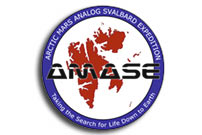NASA Arctic Mars Analog Svalbard Expedition Field Report (AMASE 2007): Settling In

08.16.07
The second helicopter day brought in the final AMASE scientists to join the crew along with spare parts! The spare pieces we needed for our GCMS had been overnighted to Marilyn Fogel in the US for her to bring over by plane and then helicopter. It turns out this is by far the fastest method of getting spare parts to a remote boat in Svalbard.
With helicopter access for the day, a small group went out to a nearby glacier to collect snow algae samples and study them using Raman spectroscopy. Really antsy to get off the ship, I was hoping to be able to go along and help sample. Unfortunately, there weren’t enough crampons available (necessary for a safe escape by foot if the weather changed suddenly and the helicopter couldn’t return for a pick-up), so I wasn’t able to go. Faced with another day in a dark room, I sat quietly in the rover mission operations meeting that was continuing from the previous day. At some point, a favorable weather prediction must have come in because Hans walked over and asked several folks if we wanted to take a brief helicopter ride up to the glacier to at least have a peek at the glacier research up there. I said “YES” immediately and dressed in two minutes, afraid to be left behind.
The glacier was beautiful. The two teams had set up off to the side on a flat area of the glacier. To the north there was another glacier hanging off a cliff, and jagged peaks on all the other sides created an incredibly dramatic backdrop to the experiments. The longer we stayed, the better the weather got. It was warm and hardly any wind in the snow banks along the valley walls. We collected jars of red and green snow algae while the Raman guys set up their instruments to take spectra. Their “field” equipment consisted of a desktop computer (complete with flat-screen monitor, separate keyboard and mouse; water cooler and plants excluded) and instrumentation built into a metal case.
Thermal issues had not been considered in the design, however, and we ended up having to hold the desktop computer next to the generator and then wrap it in a survival suit to keep it warm enough to turn on. Once they got everything started, they were able to detect and analyze the different types of snow algae by pointing a laser at the samples from about 7-8 meters! Sometimes it really feels like AMASE provides a window into the future. Overall, the afternoon was a load of fun. It was Paulo’s first trip off the boat since we had set sail (!) and we spent a lot of time taking photos, making snowballs, and traipsing around between the research groups.
In general, AMASE this year is much more relaxed than it was last year. I believe this is due in large part to knowing what to expect. We are doing at least at much productive research and sample collection as last year, but are not as stressed or frantic about it as most people now know the ropes and are able to work together more.
After bringing back the last group from the glacier, the helicopter fuelled up and was ready to return to Longyearbyen. People were leaving and several people were assembled to wave goodbye. It was sad to see them leave, as people tend to become friends very quickly in such a close environment. Waving from a helicopter deck is definitely a cool way of walking people to the door.
That evening, the Lance sailed to Monaco Glacier for our annual ice collecting trip. A new round of newbies went out in the orange lifeboat this year to collect hard ice that had calved off the glacier. There were not any huge calving events this year.
It was a lovely night at Monaco and so it had been decided that we should take the traditional Men in Black photo at this site as well. We dressed in our finest black, grabbed our choice accessories and piled into Zodiacs to assemble on shore. The first two Zodiacs came across a polar bear hanging out on the beach and had to relocate to another area. Finally we settled on a site with a large calving glacier in the background. Another beautiful night in Svalbard.
About Kirsten Fristad in her own words…
Kirsten Fristad here again. I’m privileged and excited to be back writing Notes from the Field on AMASE 07. I am a planetary scientist working in the Sample Analysis on Mars (SAM) Lab at the Goddard Space Flight Center in Greenbelt, Maryland where I have been for the last year and a half. I graduated from Macalester College in 2005 with a major in geology and core in astronomy knowing I wanted to pursue a research career in planetary science. Through summer internships with several planetary scientists, I developed a background in analyzing martian and lunar planetary remote sensing data and Mars analog field work in Alaska. Over the last year I have continued to organize the Goddard/SAM Team contribution to AMASE, conducted organic analyses of AMASE samples, designed and built new field hardware and participated in two other expeditions in Utah and the Mojave.
Following AMASE 07, I will be staying on in Norway as a Fulbright Scholar to begin graduate work at the University of Oslo. I am very much looking forward to exploring more of this beautiful country, reconnecting with the country of my ancestors and filling up on pickled herring and lefse!








